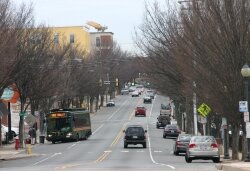Memorial Day: Drive now, RideShare later
As Memorial Day dawns, an AAA survey indicates that the number of people reporting they will drive more than 50 miles from home this weekend has dropped 100,000. Forty percent report that gasoline prices, on average $1.06 higher than last year, will curtail their travel plans.
An Associated Press poll finds that 71 percent of Americans believe rising gasoline prices cause “some hardship” and that 41 percent label that hardship “serious,” causing them to scale back holiday choices.
Once more we’re doing the same thing, just this time with feeling.
As prices spike, our individual intelligent choices become societal stupidity. Stopping the family from being together on a getaway vacation is perhaps the worst response we can make to auto fuel price spikes. Three, four or five people in the car– family time– going to Luray Caverns, Appomattox, the D-Day Memorial, The American Shakespeare Center, the Appalachian Trail, The Virginia Museum of Fine Art, or the beach is the most efficient use of those things which sit in our driveways or office parking lots 95 percent of every day. Drops in tourist traffic can literally be killers to rural American economies while injuring the sellers of oil hardly at all.
What we need to change is our daily behavior, our commute and shopping behavior.
Small trips add up to a huge difference, and they are times and places where we have the better options. Buses roll, people can carpool, trips can be “chained,” bicycles provide exercise with transporation. Sometimes it requires more effort, sometimes more planning, and always an awareness that our daily convenience is literally forcing our government to send troops to the Middle East. But this is the behavior we must change.
Overall, American car commutes today are 87 percent single occupancy vehicles.
We tell pollsters that we’d take the bus if it was more convenient but the usually when planners pull together funds from state, local and federal subsidies to make routes reasonable, ridership stays flat putting transit planners in an powerful Catch 22. In Charlottesville, for example, it costs about $400,000 to run a route which comes once an hour. Missing the bus doesn’t make the employee late; it gets him fired. So few take the chance. That, in turn, keeps ridership low, which halts the chance for expansion of the route “headway” to four times an hour, a pace that might make the route reasonable for commuters.
Since, even in the dot-com era, $1.6 million (four passes of each bus) is a lot of money, the cart and the horse basically don’t know which is which. Consequently, planners hire some survey firm– usually from out of the area– to telephone and ask, but once any subsequent service upgrades take place– if planners can find the money not wasted on the telephone survey firm– ridership stays flat.
To the harried, uninformed individual, it is always easier to continue to do what we’ve consistently done. Immediate convenience consistently trumps long-term reality especially if we don’t understand that reality while human behavior– which is not rocket science; it is much harder than that– never fits in the tiny boxes of survey forms.
But quantitative analysis is the planner’s religion, and even knowing this paradox, planners have got to have numbers to rationalize decisions. Academic precision from the model sounds like truth even though it’s only academic precision from the model– whether or not the model is flawed; whether or not humans understand their own behavior; whether or nottransportation planners realize that stated preference data is inevitably defective.
In the end, then, we kill the Memorial Day family trip rather than the daily drive.
If the nation, and maybe the planet, is going to survive, however, Americans have got to change daily transportation behavior. According to the Energy Information Agency, transportation accounts for one third of our greenhouse gas emissions. According to Commerce Department, oil importation is the largest item in our trade deficit, and 69 percent of American oil consumption is in auto fuel. The Defense Department reports that petroleum supply is the prime reason we keep two carrier groups in the Persian Gulf (and, by most accounts, is a key reason we got militarily involved in Iraq).
According to the oil industry, expanded drilling off our coasts will not decrease the demand for imported oil as long as we continue to drive 2.9 trillion miles annually, and every single auto analysts say the concept of one million electric cars on our roads by 2015 is a pipedream.
Even then, according to a number of health agencies, our drive-first paradigm is a factor in our obesity crisis, and the Texas Transportation Institute says that to hold our annual congestion losses at $78 billion annually we’d have to build 16,000 highway miles every year– a practical impossibility.
There is one simple thing that all of us can do today. We can contact RideShare, a program from the Thomas Jefferson District Planning Commission, and asked to be matched with others from our neighborhoods going to jobs close to ours. The phone number is 434-295-6165 and 888-974-5500.
Via RideShare, we can then get together with neighbors for coffee and decide whether we’re compatible enough to share 20 minutes in a car. (Rideshare even offers a guaranteed ride home– meaning that if any kind of emergency comes up, they send (and pay for) an immediate taxi or Enterprise Rental car.)
~
Transportation researcher Randy Salzman has been known, with his essays, to touch off a complaint or two.

1 comment
but please remember what the Day is all about.....................